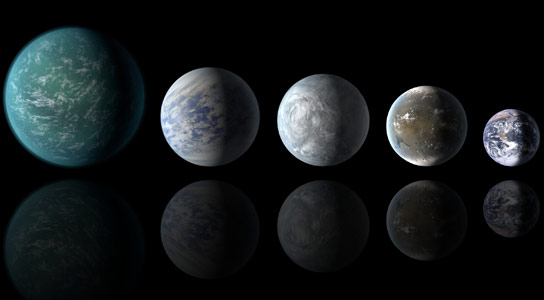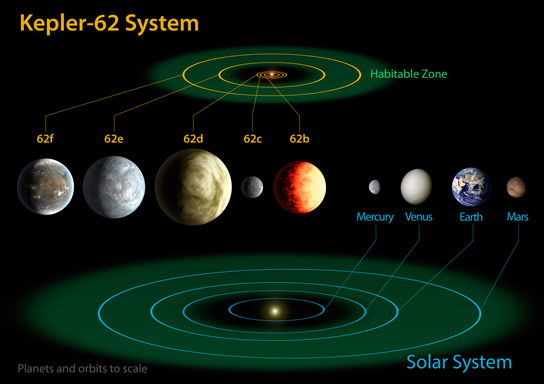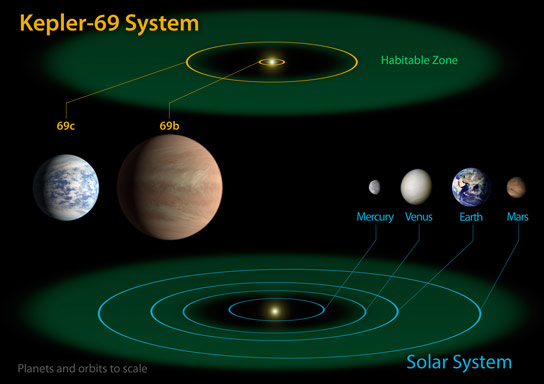Zone’ Planets

Relative sizes of all of the habitable-zone planets discovered to date alongside Earth. Left to right: Kepler-22b, Kepler-69c, Kepler-62e, Kepler-62f and Earth (except for Earth, these are artists’ renditions). Image credit: NASA Ames/JPL-Caltech.
NASA’s Kepler mission has discovered several new habitable-zone planets in two new planetary systems, Kepler-69 and Kepler-62.
Offett Field, California — NASA’s Kepler mission has discovered two new planetary systems that include three super-Earth-size planets in the “habitable zone,” the range of distance from a star where the surface temperature of an orbiting planet might be suitable for liquid water.
The Kepler-62 system has five planets; 62b, 62c, 62d, 62e and 62f. The Kepler-69 system has two planets; 69b and 69c. Kepler-62e, 62f and 69c are the super-Earth-sized planets.
Two of the newly discovered planets orbit a star smaller and cooler than the sun. Kepler-62f is only 40 percent larger than Earth, making it the exoplanet closest to the size of our planet known in the habitable zone of another star. Kepler-62f is likely to have a rocky composition. Kepler-62e, orbits on the inner edge of the habitable zone and is roughly 60 percent larger than Earth.
NASA’s Kepler mission has discovered two new planetary systems that include three super-Earth-size planets in the “habitable zone,” the range of distance from a star where the surface temperature of an orbiting planet might be suitable for liquid water.
The third planet, Kepler-69c, is 70 percent larger than the size of Earth, and orbits in the habitable zone of a star similar to our sun. Astronomers are uncertain about the composition of Kepler-69c, but its orbit of 242 days around a sun-like star resembles that of our neighboring planet Venus.
Scientists do not know whether life could exist on the newfound planets, but their discovery signals we are another step closer to finding a world similar to Earth around a star like our sun.
“The Kepler spacecraft has certainly turned out to be a rock star of science,” said John Grunsfeld, associate administrator of the Science Mission Directorate at NASA Headquarters in Washington. “The discovery of these rocky planets in the habitable zone brings us a bit closer to finding a place like home. It is only a matter of time before we know if the galaxy is home to a multitude of planets like Earth, or if we are a rarity.”

The diagram compares the planets of the inner solar system to Kepler-62, a five-planet system about 1,200 light-years from Earth in the constellation Lyra. The five planets of Kepler-62 orbit a star classified as a K2 dwarf, measuring just two thirds the size of the sun and only one fifth as bright. At seven billion years old, the star is somewhat older than the sun.
Much like our solar system, Kepler-62 is home to two habitable zone worlds, Kepler-62f and Kepler-62e. Kepler-62f orbits every 267 days and is only 40 percent larger than Earth, making it the smallest exoplanet known in the habitable zone of another star. The other habitable zone planet, Kepler-62e, orbits every 122 days and is roughly 60 percent larger than Earth.
The size of Kepler-62f is known, but its mass and composition are not. However, based on previous exoplanet discoveries of similar size that are rocky, scientists are able to determine its mass by association.
The two habitable zone worlds orbiting Kepler-62 have three interior companions, two larger than the size of Earth and one about the size of Mars. Kepler-62b, Kepler-62c and Kepler-62d, orbit every five, 12, and 18 days, respectively, making them very hot and inhospitable for life as we know it.
The artistic concepts of the Kepler-62 planets are the result of scientists and artists collaborating to help imagine the appearance of these distant worlds.
The Kepler space telescope, which simultaneously and continuously measures the brightness of more than 150,000 stars, is NASA’s first mission capable of detecting Earth-size planets around stars like our sun. Image credit: NASA Ames/JPL-Caltech
Much like our solar system, Kepler-62 is home to two habitable zone worlds, Kepler-62f and Kepler-62e. Kepler-62f orbits every 267 days and is only 40 percent larger than Earth, making it the smallest exoplanet known in the habitable zone of another star. The other habitable zone planet, Kepler-62e, orbits every 122 days and is roughly 60 percent larger than Earth.
The size of Kepler-62f is known, but its mass and composition are not. However, based on previous exoplanet discoveries of similar size that are rocky, scientists are able to determine its mass by association.
The two habitable zone worlds orbiting Kepler-62 have three interior companions, two larger than the size of Earth and one about the size of Mars. Kepler-62b, Kepler-62c and Kepler-62d, orbit every five, 12, and 18 days, respectively, making them very hot and inhospitable for life as we know it.
The artistic concepts of the Kepler-62 planets are the result of scientists and artists collaborating to help imagine the appearance of these distant worlds.
The Kepler space telescope, which simultaneously and continuously measures the brightness of more than 150,000 stars, is NASA’s first mission capable of detecting Earth-size planets around stars like our sun. Image credit: NASA Ames/JPL-Caltech
The Kepler space telescope, which simultaneously and continuously measures the brightness of more than 150,000 stars, is NASA’s first mission capable of detecting Earth-size planets around stars like our sun. Orbiting its star every 122 days, Kepler-62e was the first of these habitable zone planets identified. Kepler-62f, with an orbital period of 267 days, was later found by Eric Agol, associate professor of astronomy at the University of Washington and co-author of a paper on the discoveries published in the journal Science.
The size of Kepler-62f is now measured, but its mass and composition are not. However, based on previous studies of rocky exoplanets similar in size, scientists are able to estimate its mass by association.
“The detection and confirmation of planets is an enormously collaborative effort of talent and resources, and requires expertise from across the scientific community to produce these tremendous results,” said William Borucki, Kepler science principal investigator at NASA’s Ames Research Center at Moffett Field, California, and lead author of the Kepler-62 system paper in Science. “Kepler has brought a resurgence of astronomical discoveries and we are making excellent progress toward determining if planets like ours are the exception or the rule.”
The two habitable zone worlds orbiting Kepler-62 have three companions in orbits closer to their star, two larger than the size of Earth and one about the size of Mars. Kepler-62b, Kepler-62c and Kepler-62d, orbit every five, 12, and 18 days, respectively, making them very hot and inhospitable for life as we know it.
The five planets of the Kepler-62 system orbit a star classified as a K2 dwarf, measuring just two-thirds the size of the sun and only one-fifth as bright. At seven billion years old, the star is somewhat older than the sun. It is about 1,200 light-years from Earth in the constellation Lyra.

The diagram compares the planets of the inner solar system to Kepler-69, a two-planet system about 2,700 light-years from Earth in the constellation Cygnus. The two planets of Kepler-69 orbit a star that belongs to the same class as our sun, called G-type.
Kepler-69c, is 70 percent larger than the size of Earth, and is the smallest yet found to orbit in the habitable zone of a sun-like star. Astronomers are uncertain about the composition of Kepler-69c, but its orbit of 242 days around a sun-like star resembles that of our neighboring planet Venus. The companion planet, Kepler-69b, is just over twice the size of Earth and whizzes around its star once every 13 days.
The artistic concepts of the Kepler-69 planets are the result of scientists and artists collaborating to help imagine the appearance of these distant worlds.
The Kepler space telescope, which simultaneously and continuously measures the brightness of more than 150,000 stars, is NASA’s first mission capable of detecting Earth-size planets around stars like our sun. Image credit: NASA Ames/JPL-Caltech
Kepler-69c, is 70 percent larger than the size of Earth, and is the smallest yet found to orbit in the habitable zone of a sun-like star. Astronomers are uncertain about the composition of Kepler-69c, but its orbit of 242 days around a sun-like star resembles that of our neighboring planet Venus. The companion planet, Kepler-69b, is just over twice the size of Earth and whizzes around its star once every 13 days.
The artistic concepts of the Kepler-69 planets are the result of scientists and artists collaborating to help imagine the appearance of these distant worlds.
The Kepler space telescope, which simultaneously and continuously measures the brightness of more than 150,000 stars, is NASA’s first mission capable of detecting Earth-size planets around stars like our sun. Image credit: NASA Ames/JPL-Caltech
A companion to Kepler-69c, known as Kepler-69b, is more than twice the size of Earth and whizzes around its star every 13 days. The Kepler-69 planets’ host star belongs to the same class as our sun, called G-type. It is 93 percent the size of the sun and 80 percent as luminous and is located approximately 2,700 light-years from Earth in the constellation Cygnus.


Comments
Post a Comment